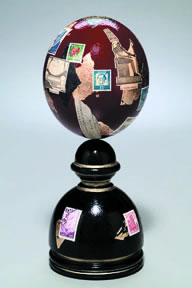 David Von der Bronx with His Amazing New Book
David Von der Bronx with His Amazing New BookDavid Sokol came over for lunch a while back and he brought a surprise - his new book which is a beautiful monograph on the work of an underappreciated German artist named Otto Neumann.
David is one of my all-time favorite Oak Parkers. He's originally from the Bronx and is proud of it but he literally wrote the book on Oak Park. He's been around in the Chicago art and museum scene including work at the director's level at Terra (alas - no more) and he has curated major shows for the Spertus Museum. He is the Director of the Museum Studies program at the U of Illinois at Chicago. It's very difficult to get a standard staple through his vitae and...he's a mensch.

The Neumann book is beautifully conceived, designed and crafted with the help of a new, local publishing concern. Prologue handled this project incredibly well. The company's principals are Alex Lubertozzi and Jennifer Barrell. I predict they will do very well in a difficult field.

Neumann's incredible draftsmanship compliments his emphasis on pleasing, interlocking forms and rhythm. In several phases of his work he experiments with an adventurous, direct use of color. Some of the figurative volume and restrained poses reminded me of Jorg Imendorf.

One interesting thing for me is the way Neumann's style responded to the zeitgeist of 20th century art. His "periods" evolve and break with the decades in a manner similar to other, better known europeans. But this gives an unfair impression that he was a copycat. Simply untrue. His take on the vernaculars of his day is always of incredible quality, craftsmanship and insight.

The other extraordinary aspect of his work lies in the dearth of recognition or critical writing. David's scholarship is the first. He explains that Neumann didn't work very hard at bringing his work to the public - because he didn't have to. The family's wealth sustained him which allowed him to save his archive.
The result of this fortunate economic encapusulation is the Neuman Estate which includes thousands of original pieces, woodcut, linocuts, lithographs and more. The Estate is responsibly managed by Neuman's nieces and nephews. Sokol observed, "They summed it up by saying, 'We want to do what is right for Uncle Ot's'.
Collectors should note that the book will stimulate critical interest in Neumann's work, life and techniques and will probably effect market value.

All images and content reserved and copyright 2006 and is courtesy of Estate of Otto Neumann, Prologue Publishing and David Sokol.

No comments:
Post a Comment